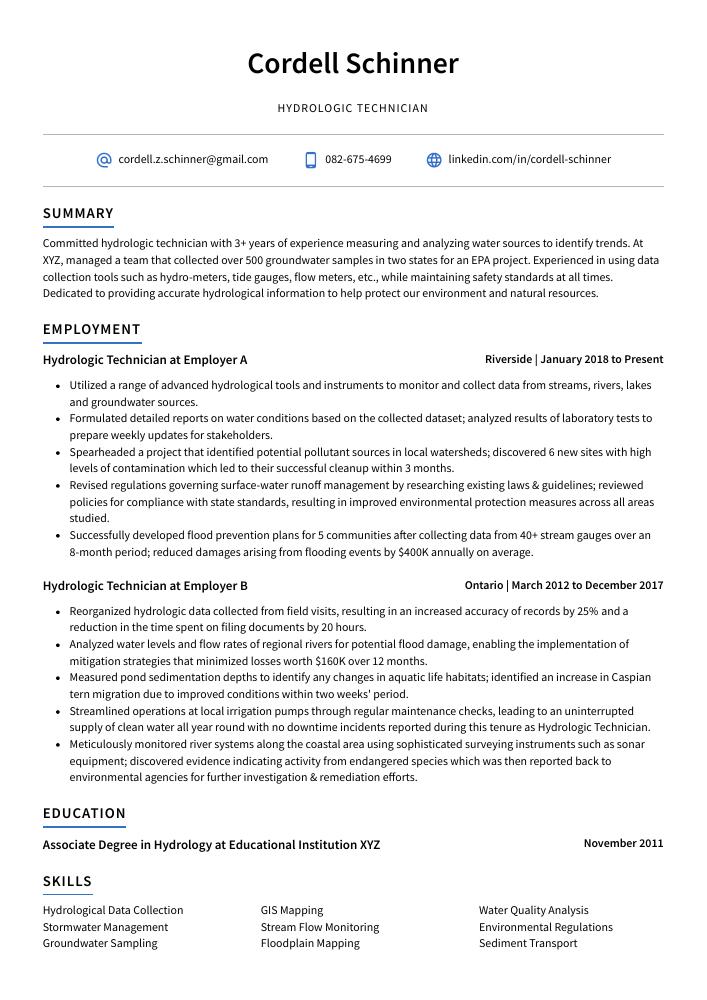Hydrologic Technician Resume Guide
Hydrologic technicians measure and study water in rivers, lakes, and aquifers. They collect data on the quantity, quality, and distribution of water resources. Hydrologic technicians may also design or operate systems to control water pollution.
You have a deep understanding of hydrology and its effects on the environment. To get noticed by employers, you need to craft an impressive resume that highlights your experience and qualifications in this field.
This guide will walk you through the entire process of creating a top-notch resume. We first show you a complete example and then break down what each resume section should look like.
Table of Contents
The guide is divided into sections for your convenience. You can read it from beginning to end or use the table of contents below to jump to a specific part.
Hydrologic Technician Resume Sample
Cordell Schinner
Hydrologic Technician
[email protected]
082-675-4699
linkedin.com/in/cordell-schinner
Summary
Committed hydrologic technician with 3+ years of experience measuring and analyzing water sources to identify trends. At XYZ, managed a team that collected over 500 groundwater samples in two states for an EPA project. Experienced in using data collection tools such as hydro-meters, tide gauges, flow meters, etc., while maintaining safety standards at all times. Dedicated to providing accurate hydrological information to help protect our environment and natural resources.
Experience
Hydrologic Technician, Employer A
Riverside, Jan 2018 – Present
- Utilized a range of advanced hydrological tools and instruments to monitor and collect data from streams, rivers, lakes, and groundwater sources.
- Formulated detailed reports on water conditions based on the collected dataset; analyzed results of laboratory tests to prepare weekly updates for stakeholders.
- Spearheaded a project that identified potential pollutant sources in local watersheds; discovered 6 new sites with high levels of contamination which led to their successful cleanup within 3 months.
- Revised regulations governing surface-water runoff management by researching existing laws & guidelines; reviewed policies for compliance with state standards, resulting in improved environmental protection measures across all areas studied.
- Successfully developed flood prevention plans for 5 communities after collecting data from 40+ stream gauges over an 8-month period; reduced damages arising from flooding events by $400K annually on average.
Hydrologic Technician, Employer B
Ontario, Mar 2012 – Dec 2017
- Reorganized hydrologic data collected from field visits, resulting in an increased accuracy of records by 25% and a reduction in the time spent on filing documents by 20 hours.
- Analyzed water levels and flow rates of regional rivers for potential flood damage, enabling the implementation of mitigation strategies that minimized losses worth $160K over 12 months.
- Measured pond sedimentation depths to identify any changes in aquatic life habitats; identified an increase in Caspian tern migration due to improved conditions within two weeks period.
- Streamlined operations at local irrigation pumps through regular maintenance checks, leading to an uninterrupted supply of clean water all year round with no downtime incidents reported during this tenure as Hydrologic Technician.
- Meticulously monitored river systems along the coastal area using sophisticated surveying instruments such as sonar equipment; discovered evidence indicating activity from endangered species, which was then reported back to environmental agencies for further investigation & remediation efforts.
Skills
- Hydrological Data Collection
- GIS Mapping
- Water Quality Analysis
- Stormwater Management
- Stream Flow Monitoring
- Environmental Regulations
- Groundwater Sampling
- Floodplain Mapping
- Sediment Transport
Education
Associate Degree in Hydrology
Educational Institution XYZ
Nov 2011
Certifications
Certified Hydrologic Technician
American Institute of Hydrology
May 2017
1. Summary / Objective
Your resume summary is the first thing a potential employer will read, so it needs to be informative and persuasive. In your hydrologic technician resume summary, you should focus on highlighting your technical skills such as data collection methods, GIS software proficiency, water sampling techniques etc., as well as any relevant certifications or qualifications that make you stand out from other applicants. You could also mention how many years of experience you have in this field and what kind of projects/tasks you have worked on successfully in the past.
Below are some resume summary examples:
Accomplished hydrologic technician with 10+ years of experience in the field. Experienced in collecting and analyzing data to determine water supply availability, risk assessment, and watershed management. At XYZ Company, designed custom tools to measure groundwater levels across a 1000-acre area while identifying potential risks of flood or drought events. Received recognition for leading successful projects that led to improved environmental sanitation conditions.
Amicable hydrologic technician with 5+ years of experience in collecting and analyzing water samples for various purposes. Experienced in data analysis, water quality assessment, and reporting results to stakeholders. Skilled at using GIS software to map groundwater level changes accurately over time and identify potential risks associated with pollution. Committed to providing accurate hydrological information for the benefit of communities across the region.
Proficient hydrologic technician with 8+ years of experience providing technical support in the field and laboratory. Skilled at researching, analyzing, and interpreting hydrological data to assist engineers in identifying water resources management strategies. Looking to join ABC Company’s team as a Hydrologic Technician to contribute my expertise towards protecting our environment while maintaining sustainable development goals.
Dependable hydrologic technician with 10+ years of experience in water resource management and data collection. Skilled in collecting, analyzing, and interpreting hydrological measurements using a variety of instruments. Seeking to join ABC Firm to leverage expertise for the benefit of their clients’ water-related projects. Successfully identified anomalous trends from past records that enabled an increase in efficiency by 16%.
Passionate hydrologic technician with 3+ years of experience collecting, analyzing, and interpreting water data to support decision-making in both private and public organizations. Skilled at using GIS systems, hydrological models, and statistical software for different research objectives. Seeking to join ABC Inc., where I can use my expertise to help collect accurate data for better understanding of water resource management.
Diligent hydrologic technician with 5+ years of experience in collecting, analyzing and interpreting hydrological data to provide accurate water resource management solutions. Proven track record of success in working collaboratively with stakeholders to ensure proper implementation of initiatives. Seeking an opportunity at ABC Company where I can apply my knowledge and skillset to help address critical environmental issues.
Enthusiastic hydrologic technician with five years of experience in hydrological data collection, analysis, and reporting. Skilled at using advanced analytical methods to identify trends in water resources. At ABC Company, identified a wastewater treatment issue that saved the company $25,000 annually. Committed to providing accurate and reliable information for informed decision-making related to water resource management.
Professional hydrologic technician with 5+ years of experience collecting and analyzing water samples from various sources. Highly skilled in using a wide range of hydrological equipment and software for accurate data collection, analysis, and reporting. Seeking to join ABC Corporation as the next Hydrologic Technician to ensure high-quality results that meet all regulatory requirements.
2. Experience / Employment
In the experience section, you provide details on your employment history. This should be written in reverse chronological order, meaning the most recent role is listed first.
Stick to bullet points primarily here; this allows the reader to digest what you have to say quickly and easily. When writing out each point, make sure to include quantifiable results that show how successful your efforts were.
For example, instead of saying “Collected data from various sites,” you could say, “Gathered hydrologic data from 30+ sites per month using a combination of manual methods and automated sensors.”
To write effective bullet points, begin with a strong verb or adverb. Industry specific verbs to use are:
- Monitored
- Collected
- Analyzed
- Assessed
- Operated
- Recorded
- Interpreted
- Calculated
- Sampled
- Measured
- Inspected
- Tested
- Documented
- Reported
- Evaluated
Other general verbs you can use are:
- Achieved
- Advised
- Compiled
- Coordinated
- Demonstrated
- Developed
- Expedited
- Facilitated
- Formulated
- Improved
- Introduced
- Mentored
- Optimized
- Participated
- Prepared
- Presented
- Reduced
- Reorganized
- Represented
- Revised
- Spearheaded
- Streamlined
- Structured
- Utilized
Below are some example bullet points:
- Collected, analyzed, and interpreted hydrological data from over 500 water sources to assess surface water availability, predict future trends, and inform strategic planning decisions.
- Monitored stream flow levels, groundwater levels, river temperature, and other indicators of environmental health for 8 rivers monthly; identified 3 potential contamination sites in the area due to excessive runoff.
- Effectively communicated findings regarding soil erosion control methods to local councils and participated in community outreach programs focused on preserving aquatic ecosystems throughout the region.
- Inspected 400+ wells across 12 counties annually for proper functioning equipment and structural integrity; reported any safety concerns or hazardous conditions immediately upon discovery resulting in a 15% reduction of pollution incidents last year alone.
- Facilitated collaborations with state agencies by providing accurate hydro-meteorological reports detailing climate forecasts along with information on precipitation patterns affecting local watersheds within an 80-mile radius of the city center.
- Compiled, analyzed, and interpreted hydrological data collected from remote areas such as rivers, streams, lakes, and reservoirs; increased accuracy of water quality measurements by 33%.
- Recorded detailed observations on the condition of various bodies of water using specialized software programs; identified and reported any signs of contamination or pollution to appropriate personnel.
- Substantially improved efficiency in field work operations by introducing a new GPS-based surveying system that reduced survey time per site by 50%.
- Introduced an automated sampling program with advanced monitoring instruments which accurately measured levels of pollutants present in surface waters over large areas at one time.
- Optimized laboratory testing procedures for detecting contaminants in groundwater samples through the use of improved filtration systems, reducing lab analysis times by 20 hours per week on average.
- Demonstrated technical proficiency in collecting and analyzing hydrological data from rivers, lakes, streams, and other water sources; improved accuracy of predictions by 17%.
- Expedited the process of stream flow measurement by utilizing automated methods and tools; reduced time spent in fieldwork on average by 15 hours per week.
- Tested soil samples to determine differences between areas that have more or less polluted groundwater supplies; identified 12 potential groundwater contaminants across 4 counties.
- Actively participated in developing effective strategies for containing natural disasters related to floods, droughts & landslides through detailed analysis of climate changes & population growth trends over a 3-year period.
- Improved quality control procedures for measuring salinity levels at various depths using advanced software programs such as ArcGIS Desktop 10x; increased overall efficiency by 22%.
- Reduced water contamination incidents by 25% through the implementation of regular water testing and analysis procedures.
- Operated a variety of hydrological equipment to measure, record, and analyze data from groundwater-level monitoring stations.
- Sampled surface-water supplies for pollutants, metal concentrations, and other contaminants at least twice quarterly; reported findings to management team on a weekly basis.
- Structured comprehensive reports detailing test results in accordance with EPA regulations that were used to inform decisions related to resource allocation and environmental protection efforts.
- Consistently met deadlines when collecting field samples as well as completing laboratory analyses within an average time frame of 3 hours per sample set-up process/analysis cycle.
- Efficiently conducted hydrologic and hydrogeologic field operations, including surface water collection, stream flow measurements, precipitation sampling, and groundwater well drilling; reduced operational costs by 17%.
- Reported on data collected to identify trends in regional climate patterns over time for use in land development studies and flood control initiatives; analyzed the results of 3+ years worth of research.
- Achieved 90% accuracy when calibrating equipment used for groundwater sampling activities across multiple sites throughout the region.
- Calculated daily evaporation rates from a variety of sources like lakes, rivers, and ponds using advanced mathematical models; improved prediction accuracy by 10%.
- Evaluated aquatic habitat quality based on observations made during monthly monitoring trips to local wetlands or other natural bodies of water; identified 11 new areas needing conservation efforts within 2 months on the job.
- Presented findings of hydrological studies to senior management, helping them make informed decisions that improved water supply and quality by 15%.
- Assessed the impact of climate change on watersheds in a region; identified potential threats and recommended solutions for protecting local ecosystems with minimal disruption.
- Advised clients on environmental regulations regarding surface water use, contributing to the successful completion of six major projects within budget parameters.
- Represented agency at public hearings & conferences related to wetlands protection efforts; helped create awareness about sustainable groundwater utilization practices among stakeholders from different industries across three states.
- Reliably collected data from field samples using advanced scientific equipment such as seepage meters, flow gauges, etc.; analyzed results and reported findings accurately within time constraints (+20 hours/week).
- Participated in the collection and analysis of data on water resources, hydrologic cycles, surface runoff, and groundwater levels; processed over 100 soil samples in a month to determine erosion rates.
- Coordinated with other technicians to monitor stream flow conditions by taking discharge measurements at various sites every week; developed an efficient system for comparing current readings against historical records.
- Documented all findings regarding changes in water quality or quantity through detailed reports that included graphs, charts & tables; successfully produced 20+ comprehensive documents per quarter for review by senior staff members.
- Resourcefully identified potential sources of contamination such as septic tanks, agricultural runoff, or industrial waste using field assessment techniques; reduced environmental hazards by 25%.
- Mentoredjunior-levell technicians on proper safety protocols when conducting lab tests & collecting field samples from remote locations; provided feedback which helped reduce laboratory errors by 10%.
- Developed and implemented hydrologic monitoring plans for local watersheds, gathering accurate data on water levels and flow rates in both surface and groundwater systems to identify potential impacts of climate change.
- Prepared detailed reports outlining the results from field measurements, analyzing over 350 soil samples and recording daily precipitation amounts with a 99% accuracy rate.
- Diligently monitored stream gauges, sediment traps, and other equipment used during research projects; maintained operational efficiency by replacing faulty parts or calibrating devices within 4 hours time frame upon request.
- Interpreted complex hydrological models to determine areas prone to flooding risk or drought conditions; identified an additional 10 sources of possible contamination, which were later addressed by appropriate authorities resulting in a 20% improvement in overall water quality standards within the region.
3. Skills
Skill requirements will differ from employer to employer – this can easily be determined via the job advert. Organization ABC may require experience in collecting and analyzing water samples, while Organization XYZ may need someone with knowledge of hydrological models.
For this reason, you should tailor the skills section of your resume to each job that you are applying for. This is important because many employers use applicant tracking systems these days; they scan resumes for certain keywords before passing them on to a human.
In addition to listing relevant qualifications here, it’s also wise to discuss them further in other areas such as the summary or experience section.
Below is a list of common skills & terms:
- Aquifer Testing
- Environmental Regulations
- Floodplain Mapping
- GIS Mapping
- Groundwater Sampling
- Hydrological Data Collection
- Sediment Transport
- Stormwater Management
- Stream Flow Monitoring
- Water Quality Analysis
4. Education
Including an education section on your resume will depend on the level of experience you have. If you are a recent graduate with no professional experience, it is important to list your educational background below your resume objective. However, if you already have extensive work history in hydrology and related fields, an education section may not be necessary.
If including an education section, make sure to highlight any courses or topics that are relevant to being a successful hydrologic technician.
Associate Degree in Hydrology
Educational Institution XYZ
Nov 2011
5. Certifications
Certifications are an important part of any job application, as they demonstrate to potential employers that you have the necessary skills and knowledge for a particular role. Certifications can come from many sources such as universities, professional organizations, or industry-specific certifying bodies.
Including your certifications on your resume is essential in order to show off your qualifications and give yourself an edge over other applicants. Make sure to list each certification clearly with its name, date obtained, and issuing body so that hiring managers know exactly what you are certified in.
Certified Hydrologic Technician
American Institute of Hydrology
May 2017
6. Contact Info
Your name should be the first thing a reader sees when viewing your resume, so ensure its positioning is prominent. Your phone number should be written in the most commonly used format in your country/city/state, and your email address should be professional.
You can also choose to include a link to your LinkedIn profile, personal website, or other online platforms relevant to your industry.
Finally, name your resume file appropriately to help hiring managers; for Cordell Schinner, this would be Cordell-Schinner-resume.pdf or Cordell-Schinner-resume.docx.
7. Cover Letter
A cover letter is an essential part of any job application. It is a document which introduces you to the employer, explains why they should hire you and gives them more details than what your resume can provide.
Cover letters are usually made up of 2 to 4 paragraphs that give recruiters insight into who you are as a person and how your skills match with the role on offer. Although not always required, writing one will help make sure that employers have all the information needed when considering candidates for a position.
Below is an example cover letter:
Dear Clemens,
I am writing in response to your advertisement for a Hydrologic Technician at the US Geological Survey. With my experience conducting hydrologic studies, collecting water samples, and operating various types of equipment, I am confident that I would make a valuable contribution to your team.
In my current role as a Hydrologic Technician, I have been responsible for conducting streamflow measurements, water quality sampling, and data collection. I have also operated various types of equipment, such as flow meters and water samplers. In addition, I have created maps and diagrams using GIS software to visually represent data collected from fieldwork. My experience has given me a strong foundation in hydrology that I can build on in this new role.
I am excited about the opportunity to use my skills and knowledge to contribute to the USGS’s mission of protecting life and property from natural disasters through sound science. I look forward to speaking with you soon about how I can be an asset to your team. Thank you for your time and consideration.
Sincerely,
Cordell
Hydrologic Technician Resume Templates
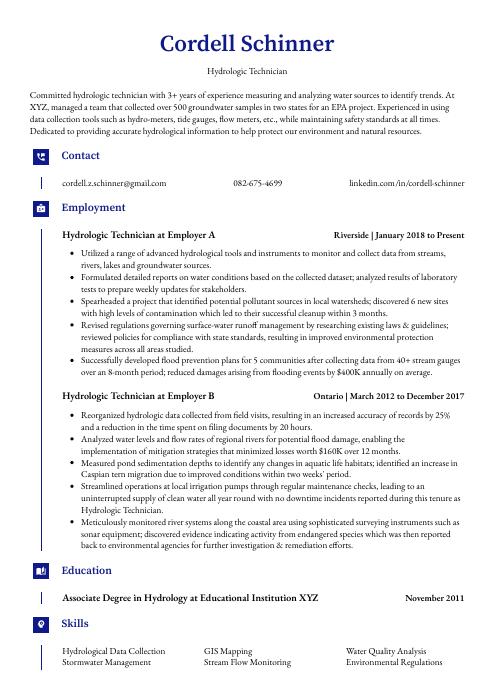 Gharial
Gharial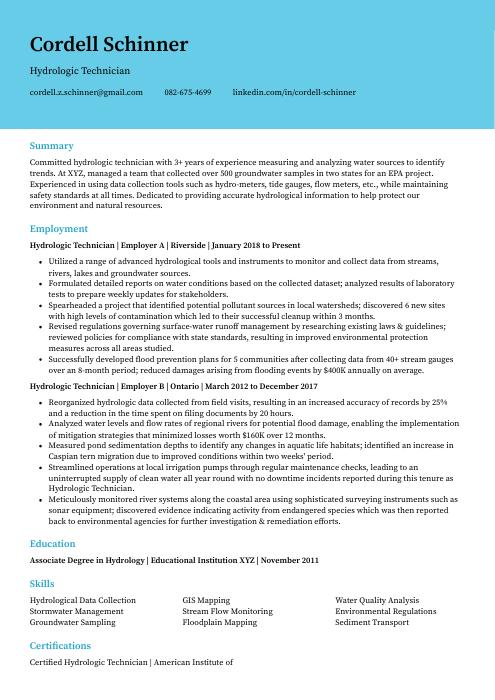 Dugong
Dugong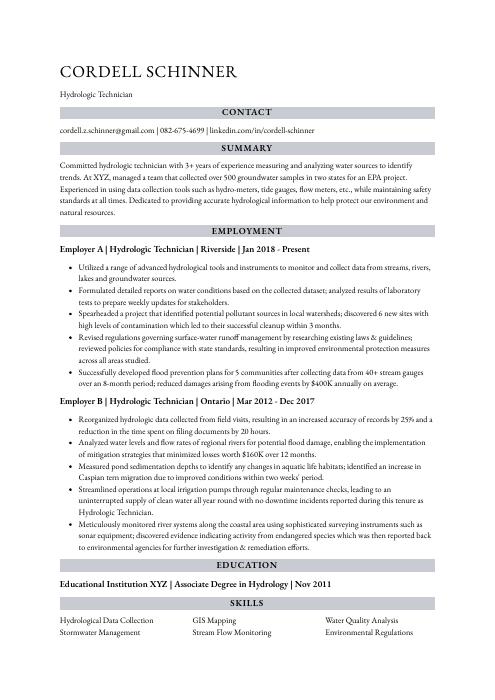 Numbat
Numbat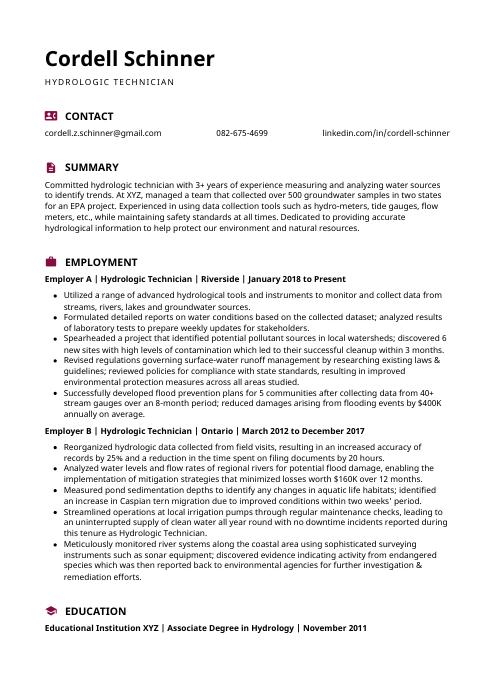 Hoopoe
Hoopoe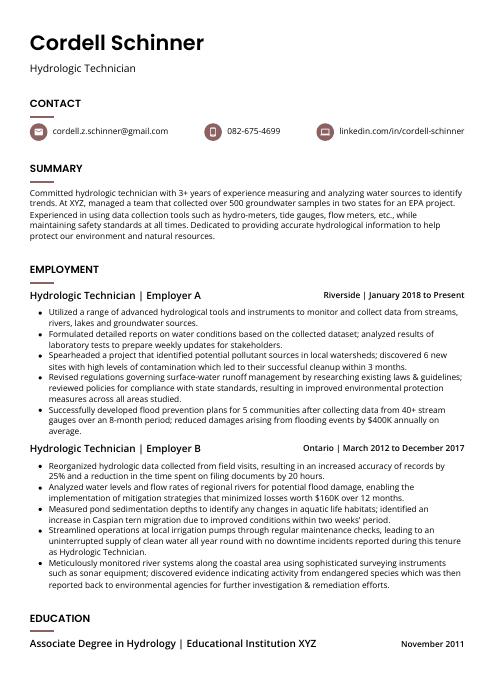 Fossa
Fossa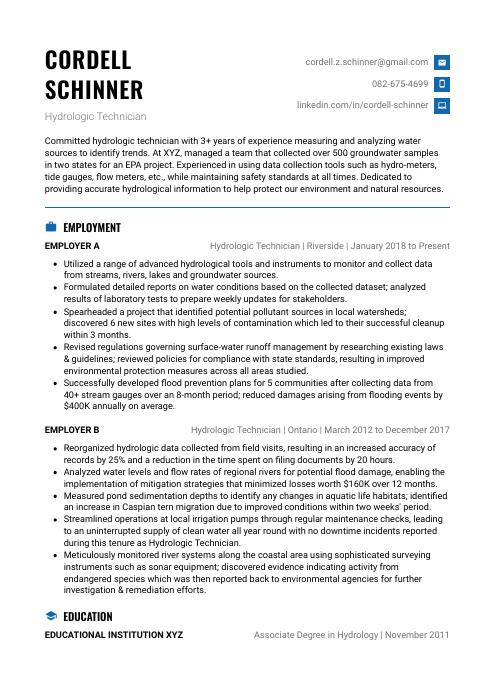 Echidna
Echidna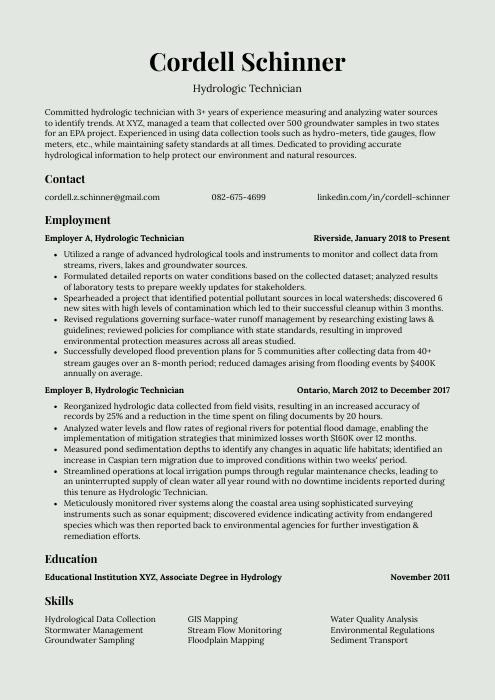 Saola
Saola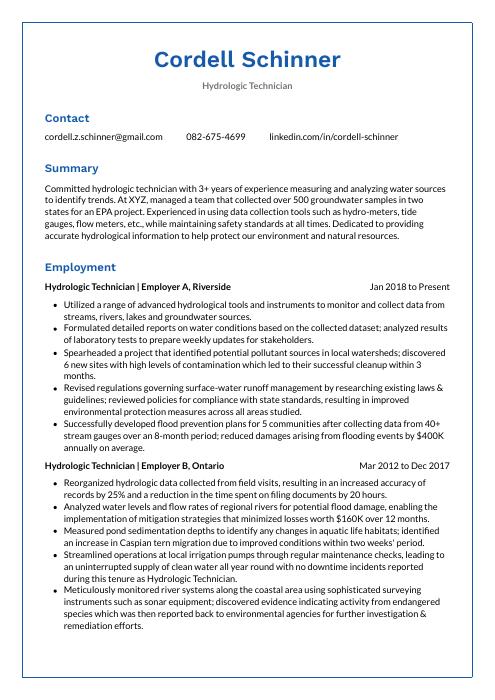 Markhor
Markhor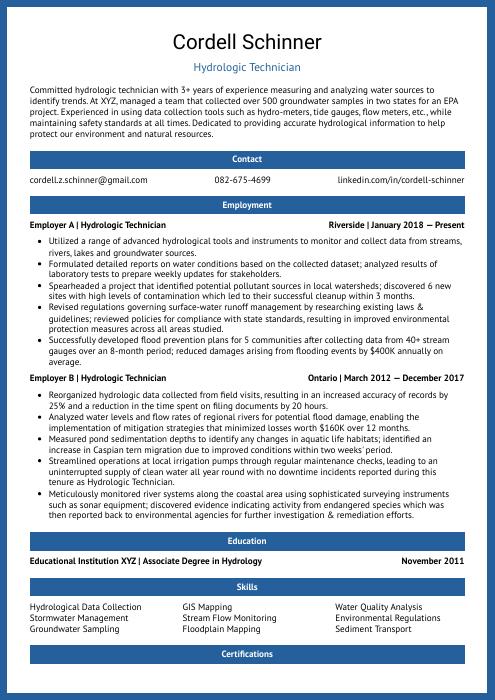 Ocelot
Ocelot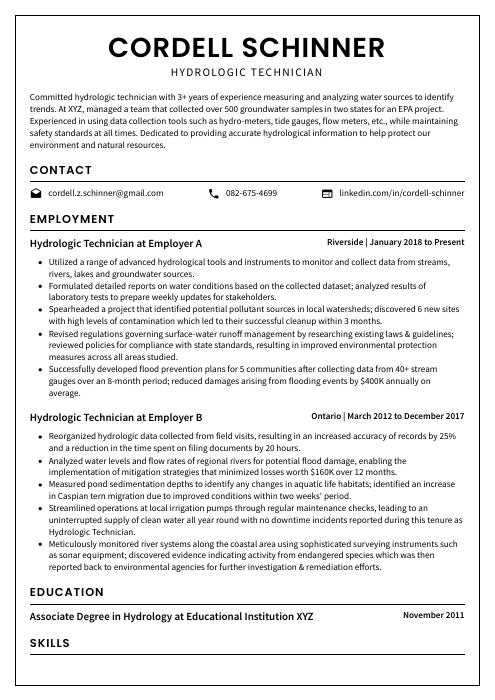 Cormorant
Cormorant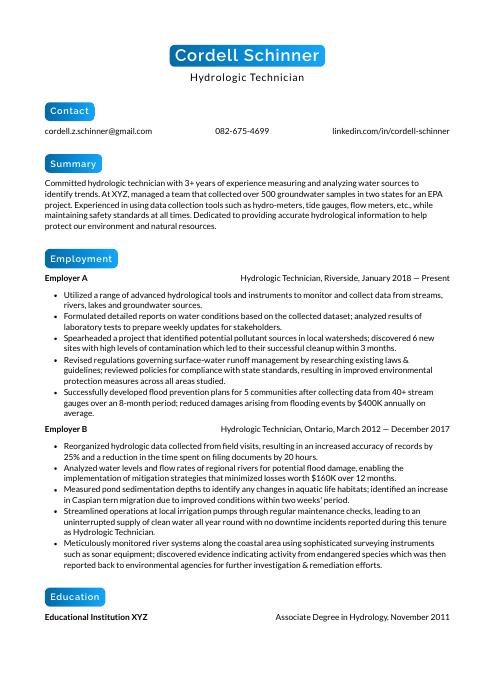 Kinkajou
Kinkajou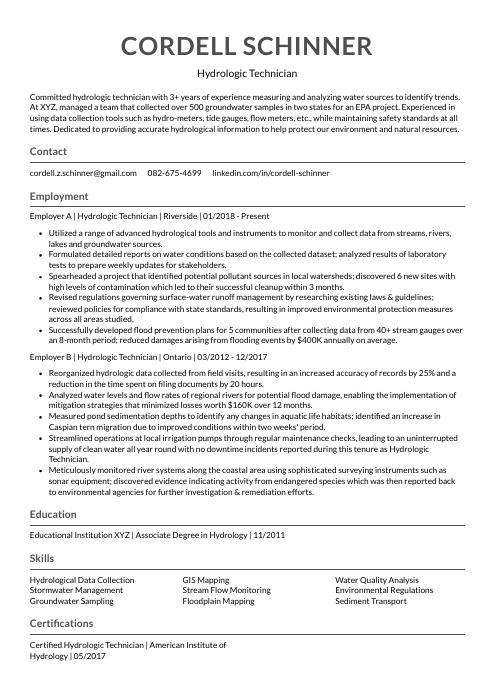 Indri
Indri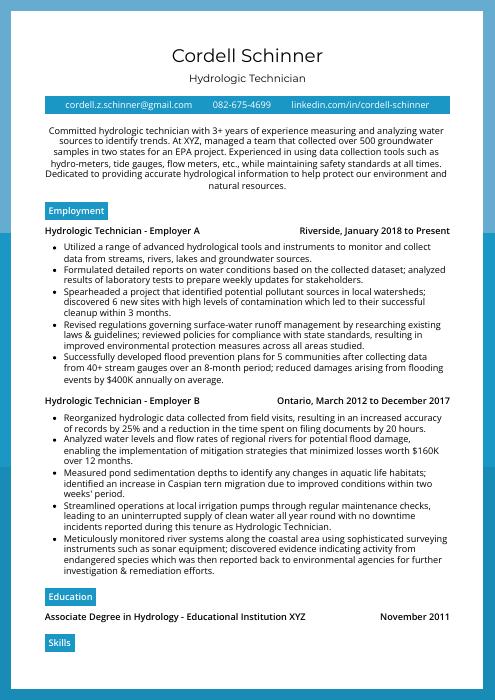 Rhea
Rhea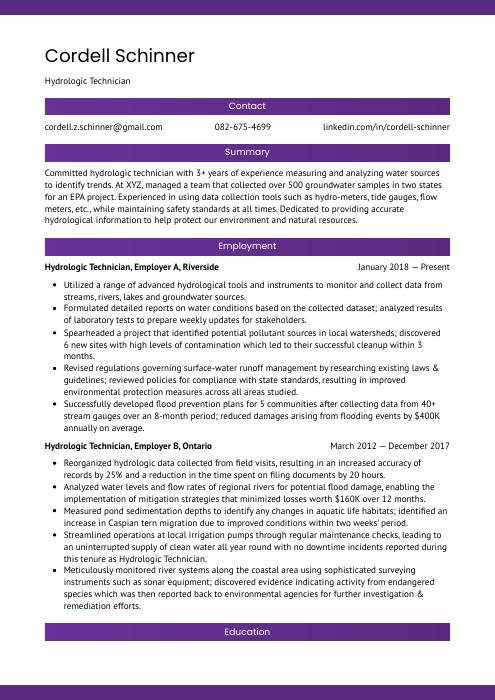 Jerboa
Jerboa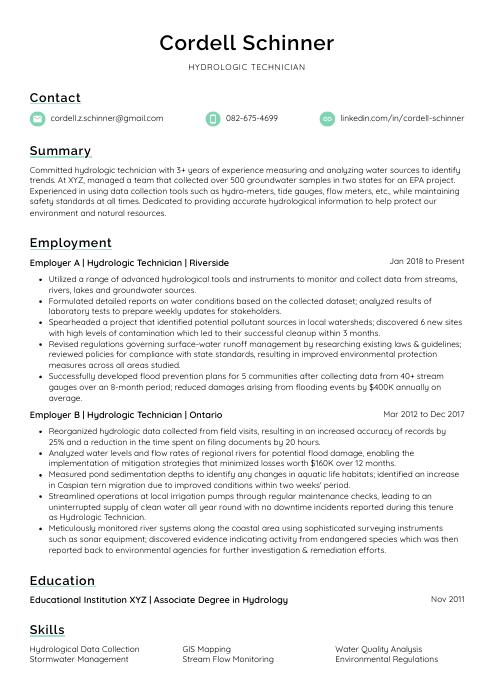 Lorikeet
Lorikeet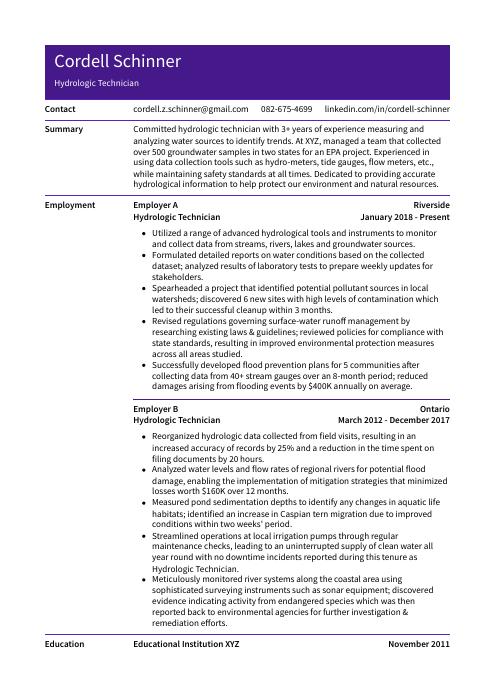 Pika
Pika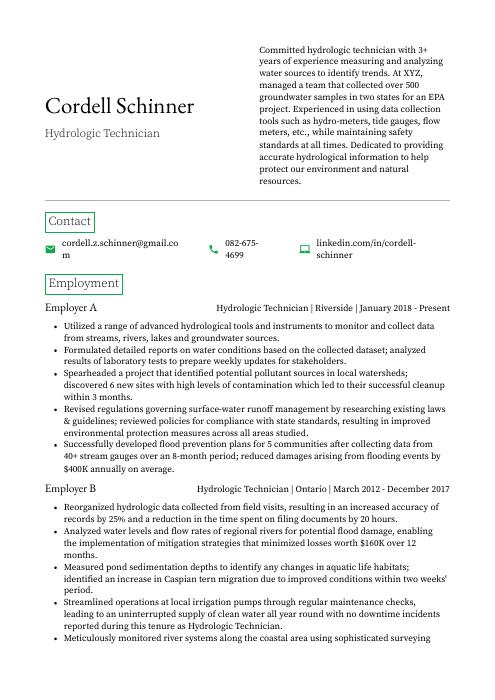 Quokka
Quokka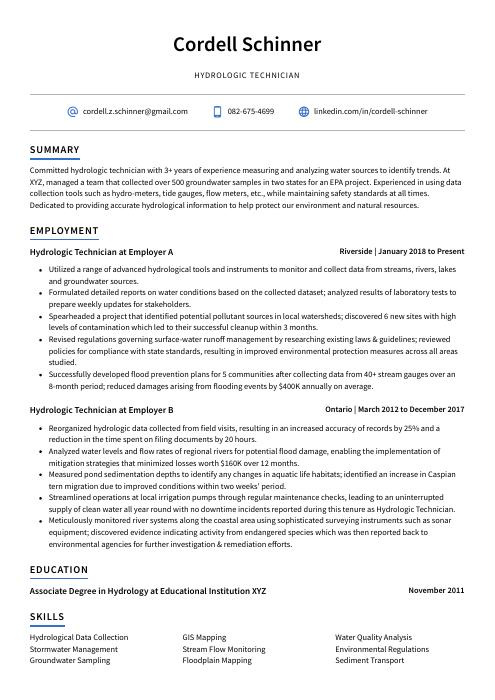 Axolotl
Axolotl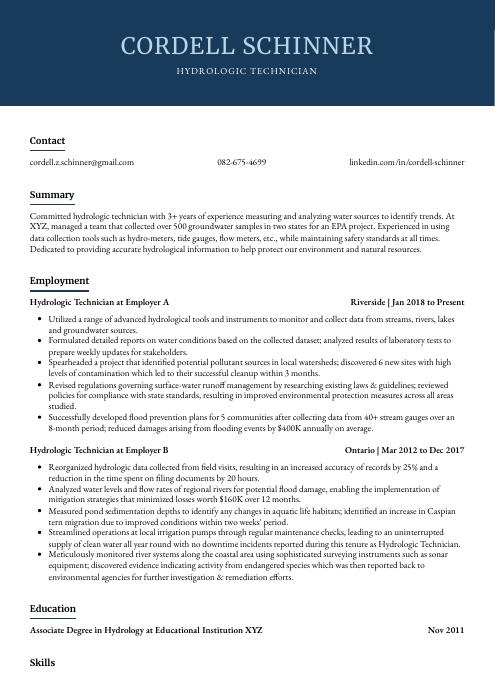 Bonobo
Bonobo Rezjumei
Rezjumei
